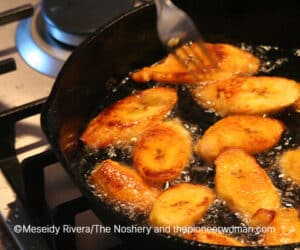“Where can I get plantains from in Abu Dhabi?” is a question we often get asked at the shop. It’s a straightforward question, we’re straightforward people so here’s is a straightforward answer … with a few caveats.
At WtoW, we provide fried plantain as a firm favourite on our menu.
But if you want to cook them yourself, here are a list of outlets that sell raw plantains (also, check out our “How to Fry Plantains” video):
- Mina Port – although, you may have to buy in bulk because they tend to sell wholesale
- Lulu and Carrefour – we’ve found plantains are stocked in most of the large hypermarket Lulus and in the Yas Mall Carrefour
- Small community grocery shops – in the UK these would be called ‘corner shops’ and in the US they’d be called ‘convenience stores’ (sorry, not too sure what the generic names are for these establishments in any other country). In Abu Dhabi, these shops tend to be found nestled amongst residential flats in the city.
Oh, and here in the desert, it doesn’t matter whether you call them “plan-tin” or “plan-tayn”; you use either of these terms and you’re guaranteed to be received by a thoroughly confused, vacant expression. Here, the vendors call them “Indian bananas” … and that puts to bed the age old debate about “plan-tin” or “plan-tayn.”
Let us know in the comments below if you’ve found plantains anywhere else in Abu Dhabi. Also, let us know how you prefer your plantain and what you eat it with. You never know, your preference could make it onto the WtoW menu.
So, there’s your answer, but, if you’re new to the culinary wonder that is plantain, please read on for a brief beginner’s guide:
What is plantain?


They’re a bit like a banana but they’re bigger, they’ve got thicker skins and we wouldn’t recommend eating them raw as a snack in your lunchbox (although, when fried, this would be perfect in your lunchbox).
How is it eaten?
It really depends what part of the world you’re in. Plantains are eaten across Africa, the Caribbean, Latin America and India. Our background is West African (Sierra Leone) and the Caribbean (Trinidad&Tobago and Jamaica). Growing up, we would eat plantains either boiled or fried (when ever we’d have the choice, which growing up West African and Caribbean, wasn’t very frequently, we’d always prefer our plantains fried).
What do you eat it with?
We’re the worst people to ask this question. We LOVE plantains so, we’d say, fry them and eat them with EVERYTHING … except for tomato ketchup (… yep, someone once came into the shop and asked for ketchup to have with their plantains … KMT … SMH). However, traditionally, in Sierra Leone, Trinidad&Tobago and Jamaica, plantains are eaten as a side dish to accompany a variety of meals: Chicken stew and Jollof rice, Jerk chicken and rice and peas, curry goat and dhalpuri roti (all dishes, we hasten to add, that can be found on the WtoW menu).
How do you know when it’is ripe?
You may see plantains green, yellow or even brownie-black in colour. The hue just indicates how ripe the plantain is. The darker and softer it is, the sweeter it is. If you’re lucky, supermarkets that don’t know much about plantains may offer deals on bunches of plantains when they get to this stage as they think the plantain is off. Growing up, our mum and aunties used to fleece the poor supermarkets on a weekly basis, buying discount plantains and frying up super sweet dishes to accompany our Jollof rice and Jerk chicken all weekend! BANGIN!!

[image credit: Meseidy Rivera/The Noshery and thepioneerwoman.com]
Whilst it all depends on preference, plantains tend to be ripe when the skin colour is yellow with a few brownie-black patches on and it is firm to touch.
What is this “plan-tin”/“plan-tayn” debate all about?
West Africans and Caribbeans pronounce “plantain” in two different ways. Whilst it’s not a hard-and-fast rule, West Africans tend to say “plan-tayn” and Caribbeans tend to say “plan-tin.” Amongst the diaspora, where West Africans and Caribbeans converge, for example in the UK, the pronunciation debate rages on. You ask a Brit of West African or Caribbean descent how to pronounce “plantain” and battle lines may be drawn. Don’t say we didn’t warn you.
We hope you now feel a little more knowledgeable about one of our favourite dishes. If you haven’t tried plantain yet, please do get involved the next time you visit us at WtoW or watch our “How to Fry Plantains” video and make them yourself.
